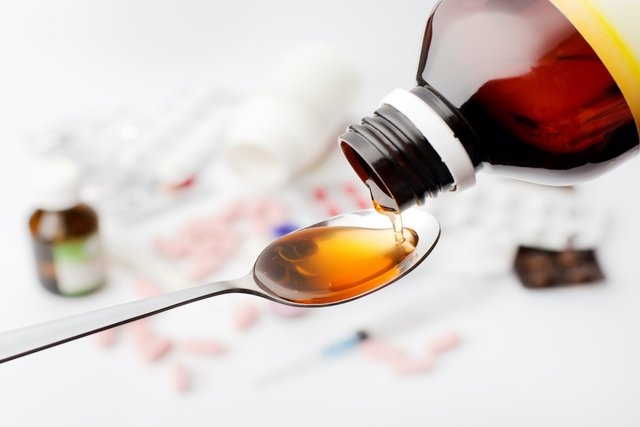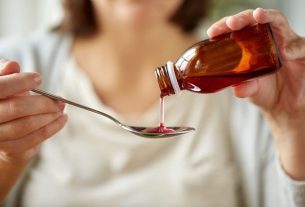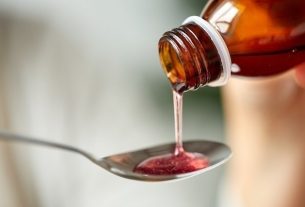Coughing with sputum is the body’s reflex to expel phlegm from the respiratory system and, therefore, should not be avoided with medications that inhibit the elimination of phlegm, but rather with medications that make the phlegm more liquid and easier to eliminate and that promote their expulsion, in order to treat the cough more quickly and effectively.
Generally, the expectorant active substances used in children are the same as those used by adults, however, pediatric formulas are prepared in smaller doses. On most of the packaging of these medicines, “children’s use”, “pediatric use” or “children” are mentioned, to make it easier to identify.
Before giving the syrup to the child, it is important to take the child to the pediatrician, so that the most appropriate expectorant can be prescribed on an individual basis and to identify what may be causing the cough. Find out what each color of phlegm can mean.
Some of the medications indicated to treat cough with phlegm are:
1. Ambroxol
Ambroxol for children helps to make phlegm less thick, facilitating its elimination and can be found in the form of a 15mg/5mL pediatric syrup or a 7.5 mg/mL oral solution for children over 2 years old, as a generic or with the trade names Mucosolvan or Sedavan.
Ambroxol drops or syrup are not recommended for children under 2 years of age.
How to use
Doses of pediatric ambroxol depend on age or weight and the pharmaceutical form intended to be used, drops or syrup, and include:
The doses of ambroxol drops or pediatric syrup can also be calculated by the pediatrician considering the child’s weight.
Contraindications
Ambroxol should not be used by children who are allergic to ambroxol or any other component of the formula and should only be administered to children under 2 years of age if advised by a doctor.
Possible side effects
Although it is generally well tolerated, ambroxol can cause some side effects such as taste changes, nausea, vomiting, diarrhea, heartburn or poor digestion.
2. Acetylcysteine
Acetylcysteine for children helps relieve coughs, as they act to make phlegm more liquid, facilitating its elimination, and is available in the form of a 20mg/mL pediatric syrup, as a generic or under the trade names Fluimucil or Cisteil.
How to use
Acetylcysteine syrup must be taken orally, using the measuring cup provided in the package. The normally recommended doses are:
- Children aged 2 to 4 years: the recommended dose is 5 mL, 2 to 3 times a day, as advised by the pediatrician;
- Children over 4 years old: the recommended dose is 5 mL, 3 to 4 times a day, as advised by your pediatrician.
The treatment time with pediatric acetylcysteine syrup must be guided by the pediatrician and is generally 5 to 10 days.
Contraindications
Acetylcysteine should not be used by children who are allergic to acetylcysteine or any other component of the formula and in children under 2 years of age, unless recommended by a doctor.
Possible side effects
Some of the most common side effects that can occur during treatment with acetylcysteine are gastrointestinal disorders, such as nausea, vomiting or diarrhea.
3. Bromexin
Bromhexine helps dissolve phlegm, allowing it to be eliminated more easily, and is available in the form of drops or 4mg/5mL children’s syrup and can be found generically or under the trade names Bisolvon or Pulmed.
How to use
Doses of bromhexine for children depend on age or weight and the pharmaceutical form intended to be used, drops or syrup, and include:
The duration of treatment with bromhexine children’s syrup or drops should be guided by the pediatrician.
Contraindications
This medicine should not be used by children who are allergic to bromhexine or any other component of the formula and in children under 2 years of age.
Furthermore, bromhexine syrup should not be used by children who have fructose intolerance.
Possible side effects
Some of the side effects that may occur during treatment with bromhexine are nausea, vomiting or diarrhea.
4. Carbocisteína
Carbocisteine is an expectorant medicine that facilitates the elimination of phlegm and can be found in the form of 20mg/mL children’s syrup, as a generic or under the trade name Mucofan.
How to use
Carbocisteine should be used orally and should not be used by children under 2 years of age.
To use carbocisteine children’s syrup, you must use the measuring cup provided in the packaging. The normally recommended dose for children between 2 and 12 years of age is 0.25 mL of syrup for each kg of body weight, which is equivalent to 5 mg of carbocisteine per kg of weight, 3 times a day, or as directed by the doctor. pediatrician.
The duration of treatment with children’s carbocisteine syrup should be guided by the pediatrician.
Contraindications
This medicine should not be used by children who are allergic to carbocisteine or any other component of the formula and in children under 2 years of age.
Side effects
Some of the most common side effects that can occur during treatment with carbocisteine are gastrointestinal disorders, such as nausea, diarrhea and gastric discomfort.
5. Guaifenesina
Guaifenesin is an expectorant syrup, indicated for flu and colds, which acts to make phlegm less thick, which facilitates its elimination and is available in the form of 100 mg/15mL children’s syrup, as a generic or under the trade name Transpulmin mel children’s syrup . See other syrups for children’s flu.
How to use
To use guaifenesin children’s syrup, you must use the measuring cup provided in the packaging. Doses depend on the child’s age or weight, and include:
- Children aged 2 to 6 years: the recommended dose is 7.5 mL (50 mg) every 4 hours, that is, 1 dose every 6 hours, or as advised by your pediatrician;
- Children aged 6 to 12: the recommended dose is 15 mL (100 mg) every 4 hours, that is, 1 dose every 6 hours, or as directed by your pediatrician.
The maximum daily limit for administering the medicine to children is 6 doses per day, that is, for children between 2 and 6 years old, 300 mg per day should not be exceeded, and for children between 6 and 12 years old, the maximum dose is 600 mg per day.
The duration of treatment with guaifenesin syrup for children should always be advised by the pediatrician.
Contraindications
This medicine should not be used by children who are allergic to guaifenesin or any other component of the formula and in children under 2 years of age.
Furthermore, this syrup should be used with caution by diabetic children as it contains sugar.
Possible side effects
Some of the side effects that may occur during treatment with guaifenesin are gastrointestinal disturbances, such as nausea, diarrhea, gastric discomfort, drowsiness or headache.
6. Acebrophilin
Acebrophylline is a medicine that helps eliminate phlegm more easily and is available in pediatric syrup 5 mg/mL, as a generic or under the trade names Brondilat or Filinar.
How to use
Pediatric acebrophylline syrup is indicated for children from 2 years of age, and must be taken orally, using the 10 mL measuring cup provided in the package. The normally recommended doses are:
- Children aged 2 to 3 years: the recommended dose is 2 mg per kg of body weight per day, divided into two administrations, every 12 hours, or as advised by the pediatrician;
- Children aged 3 to 6 years: the recommended dose is half a measuring cup, which corresponds to 5 mL of syrup every 12 hours, or as advised by your pediatrician;
- Children aged 6 to 12: the recommended dose is 1 measuring cup, which corresponds to 10 mL of syrup, every 12 hours, or as advised by your pediatrician;
- Teenagers from 12 years old: The recommended dose is 1 measuring cup, which corresponds to 10 mL of syrup, every 12 hours, or as directed by your pediatrician.
The duration of treatment with pediatric acebrophylline syrup should be guided by the pediatrician.
Contraindications
This syrup should not be used by children who are allergic to acebrophylline or any other component of the formula or by children with severe liver, kidney or cardiovascular diseases, active peptic ulcers or a history of seizures.
Furthermore, it should also not be used on children under 2 years of age.
Possible side effects
Some of the side effects that may occur during treatment with acebrophylline syrup for children are constipation, diarrhea, excessive salivation, dry mouth, nausea, vomiting, generalized itching or excessive tiredness.
Also discover some natural remedies that can help relieve coughs.

Sign up for our newsletter and stay up to date with exclusive news
that can transform your routine!
Warning: Undefined array key "title" in /home/storelat/public_html/wp-content/plugins/link-whisper-premium/templates/frontend/related-posts.php on line 12
Warning: Undefined array key "title_tag" in /home/storelat/public_html/wp-content/plugins/link-whisper-premium/templates/frontend/related-posts.php on line 13




